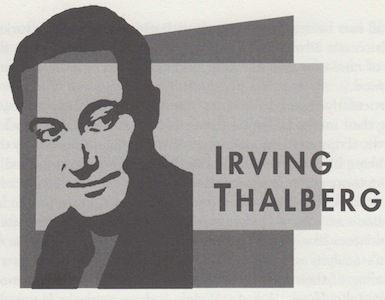Born: May 30, 1899, Brooklyn, NY
Died: September 14, 1936, Santa Monica, CA
His record is too excellent for me not to regard him as the master.
—David O. Selznick
The emerging studio system of the 1920s shifted power from the stars and directors to omnipotent producers, whose job it was to make formulaic pictures that were assured of success. To do this, studios sought experts in efficiency and profitability, the best of whom was Irving G. Thalberg. At the pinnacle of his power, Thalberg’s dominion over the entire Metro-Goldwyn-Mayer operation was complete. He controlled the finances, hired and fired directors, discovered new screen personalities, coordinated with artists and technicians and, nearly all by himself, transformed MGM into the most profitable and respected studio in the industry. He carved out a position as the prototypical modern producer of motion pictures and instituted many of the tests that gauge audience reactions to films as a way of improving their financial prospects.
Irving Thalberg’s rise through the ranks of Hollywood was meteoric. He began as a humble secretary at Universal, and before reaching the age of twenty-one he had been promoted to general manager (One anecdote relates that Universal executives assigned a special bookkeeper to assist Thalberg because he wasn’t yet old enough to have check-signing authority).
He left Universal to join Louis B. Mayer’s production company, building a reputation as a boy wonder. When Metro Pictures merged with several other small production studios to become Metro-Goldwyn-Mayer in 1924, investors insisted that an independent party keep an eye on the manner in which Metro boss Louis B. Mayer would run the new venture. Thalberg got the assignment, largely due to his reputation for high-quality films, and his inclusion was packaged with the deal. The rocky relationship between the jealous president and the wunderkind didn’t affect productions at first, but soon Thalberg’s emerging power threatened Mayer.
To ensure that MGM completed the merger smoothly, the studio elevated Thalberg’s stature to supervisor of production, giving him total control over all projects. His autocratic style perfectly suited the needs of the assignment. He had an innate sense of entertainment, he was an organized and meticulous taskmaster and he did his homework. To keep in touch with trends, Thalberg frequently sat through movies with the general public.
His first real challenge on the job was corralling the costs of flamboyant director Erich von Stroheim, the studio’s biggest talent and biggest spender, and with whom Thalberg previously had conflicts at Universal over excessive costs and unmanageably long film lengths, replacing him midway through the production of Merry-Go-Round (1922). On the mammoth silent film Greed (1924), Thalberg and Stroheim clashed in a scene that has become Hollywood legend. Discovering the excessive indulgences of Stroheim’s production, including bills for imported caviar and champagne, Thalberg stripped the film of the director’s control and edited a ten-hour film to just 140 minutes. In one swift move, Thalberg essentially ended Stroheim’s career, ruined his reputation and established the lengths to which MGM would go to deter excessive costs.
If Thalberg was a fabled cost-cutter, he was even more the legendary census-taker. His greatest contribution to motion picture production was the audience litmus test. Seeking to ascertain public interest, Thalberg first used The Big Parade (1925) to collect opinions and reactions to the film’s story, stars, costumes and settings. He followed up intensive preproduction questionnaires with a series of preview screenings designed to predict box office success. Exit polls were conducted on everyone who saw the film, then he unwaveringly filmed retakes to bend to the tastes of moviegoers. He would not hesitate to change an ending or eliminate a character completely on the basis of feelings he perceived from audiences. Gauging the line between commerce and art, Thalberg made all decisions on gut instinct but tempered his whims with the reports he collected. The result was such hits as Mutiny on the Bounty (1935), A Night at the Opera (1935) and San Francisco (1936). This screening process was faithfully applied to all MGM productions and is still in widespread use today.
Second only to Thalberg’s acute sense of public opinion was his reliance on talent. He personally handled the careers of MGM’s greatest stars, including Lon Chaney, Greta Garbo, Jean Harlow, Clark Gable, Spencer Tracy and the Marx Brothers. Having great respect for the immeasurable value of the production crew to his assignments, he favored a hand-picked group of specialists, including director Victor Fleming, writer Anita Loos and art director Cedric Gibbons.
The Good Earth (1937) was his last hurrah, featuring a stunning film cast, and cut with Thalberg’s input at nearly every turn. It was the only film in which Thalberg gave himself an on-screen credit. A persistent heart condition slowed him in 1933, and in the middle of production for the Marx Brothers’ A Day at the Races (1937) he caught pneumonia and died at the age of thirty-seven. Today, the Thalberg Memorial Award, instituted in 1937, is given by the Academy of Motion Picture Arts and Sciences to distinguished efforts in production. A celluloid biography came by way of Elia Kazan’s adaptation of the F. Scott Fitzgerald novel The Last Tycoon, starring Robert De Niro in the role of the young impresario.
Ironically, Thalberg ranks just slightly ahead of production pioneer Thomas Ince: while Ince became famous for bending films to his strict production system, Thalberg was willing to bend his productions to the whims of the audience. Years later, studios continue to favor the Thalberg method, and his influence resonates throughout studio films that are screened for audience approval. In fact, the legacy of Thalberg is still present in the modern-day film producer—adhering to the practices of responsible budgeting, and shaping films by keeping a finger on the pulse of the public.
To read all the republished articles from ‘The Film 100,’ go to Reintroducing the Film 100 here on Keyframe.





